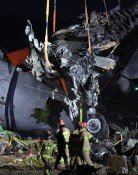N. Korea conducts nuclear torpedo test again
N. Korea conducts nuclear torpedo test again
Posted April. 10, 2023 07:53,
Updated April. 10, 2023 07:53

North Korea announced on Saturday that it conducted underwater explosion tests of the nuclear-armed unmanned underwater vehicle (nuclear torpedo) named Haeil-2 from Tuesday through Friday, following its tests of Haeil from March 21 through 23 and Haeil-1 from March 25 through 27, parading its successful underwater explosion tests of nuclear torpedoes on three occasions in 15 days. The North countered the South Korean military’s accusation that the North’s claim is exaggerated or manipulated by warning that its secret weapon, which has been developed for 11 years, is fully diversified and ready to be deployed.
“Haeil-2 cruised along an oval and eight-figure course simulating the distance of the 1,000 kilometers set in the East Sea for 71 hours and six minutes before reaching the sea near Ryongdae Port in Tanchon in South Hamgyong Province, the virtual target water, on Friday afternoon and correctly setting off the test warhead underwater,” the Korean Central News Agency reported on Saturday.
Haeil-2 traveled 1,000 kilometers underwater, which is 400 kilometers longer than Haeil-1. Even if it is launched from the northernmost waters of North Korea, it can reach any port in South Korea’s southern sea and East Sea. It is even expected to reach South Korea’s southern sea by avoiding South Korea and the U.S.’s naval surveillance network and traveling in international waters. Its travel time of 71 hours and six minutes is up to 30 hours longer than the previous record. Equipped with a larger-capacity battery, it seems that the new torpedo is improved to stay underwater longer to strike a more distant target. Haeil-2, revealed by North Korean media, seems to be longer than Haeil-1. It is also black, which is different than Haeil-1 in red.
The test timing of Heail-2 shows that North Korea intends to keep South Korea, the U.S., and Japan in check. The three countries’ naval forces conducted training simulating the invasion of North Korean nuclear torpedo in the international waters south of Jeju Island by utilizing a Nimitz-class aircraft carrier of the U.S., etc. on April 4. On Monday, the U.S.’s B-52H strategic bombers flew in and joined South Korea’s F-35A stealth fighter planes to conduct joint aerial training.
Sang-Ho Yun ysh1005@donga.com







